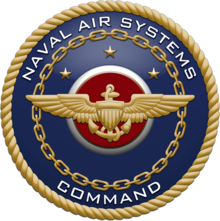| Naval Air Systems Command | |
|---|---|
 Seal of the Naval Air Systems Command | |
| Founded | 1966 |
| Country | |
| Branch | |
| Type | SYSCOM |
| Role | Naval warfare, Naval Aviation |
| Part of | SYSCOM |
| Headquarters | Naval Air Station Patuxent River Patuxent River, Maryland, U.S. |
| Website | www |
| Commanders | |
| Commander | Vice Admiral Carl P. Chebi, USN |
| Vice Commander | Captain Todd M. Evans, USN |
| Deputy Commander | Theodore J. Short Jr., SES |
| Command Master Chief | CMDCM Todd A. Anselm, USN |
The Naval Air Systems Command (NAVAIR) provides materiel support for aircraft and airborne weapon systems for the United States Navy. It is one of the Echelon II Navy systems commands (SYSCOM), and was established in 1966 as the successor to the Navy's Bureau of Naval Weapons.
NAVAIR is headquartered in Naval Air Station Patuxent River in St. Mary's County, Maryland, with military and civilian personnel stationed at eight locations across the continental United States and one site overseas.[1] The current commander as of September 2021 is Vice Admiral Carl P. Chebi, USN.[2] The vice commander is Captain Todd M. Evans, USN.[3] The deputy commander is Mr. Theodore J. Short Jr., SES.[4] The Command Master Chief is CMDCM Todd A. Anselm, USN.[5]
NAVAIR's mission is to provide full life-cycle support of naval aviation aircraft, weapons and systems operated by Sailors and Marines. This support includes research, design, development and systems engineering, acquisition, test and evaluation, training facilities and equipment, repair and modification, and in-service engineering and logistics support.
NAVAIR is organized into eight "competencies" or communities of practice namely: program management, contracts, research and engineering, test and evaluation, logistics and industrial operations, corporate operations, comptroller and counsel.
The competency alignment of the organization is changing to "mission alignment."[6]
NAVAIR provides support (through people, processes, tools, training, mission facilities, and core technologies) to Naval Aviation Program Executive Officers (PEOs) and their assigned program managers, who are responsible for meeting the cost, schedule, and performance requirements of their assigned programs.
- ^ "Naval Air Systems Command - Overview". Naval Air Systems Command. Retrieved 28 October 2020.
- ^ "Commander, Naval Air Systems Command". Naval Air Systems Command. Retrieved 28 October 2020.
- ^ "Vice Commander, Naval Air Systems Command". Naval Air Systems Command. Retrieved 28 October 2020.
- ^ "Deputy Commander, Naval Air Systems Command". Naval Air Systems Command. Retrieved 28 October 2020.
- ^ "Command Master Chief, Naval Air Systems Command". Naval Air Systems Command. Retrieved 28 October 2020.
- ^ NAVAIR Commander's Update: Expectations for 2019, archived from the original on 21 December 2021, retrieved 25 September 2019